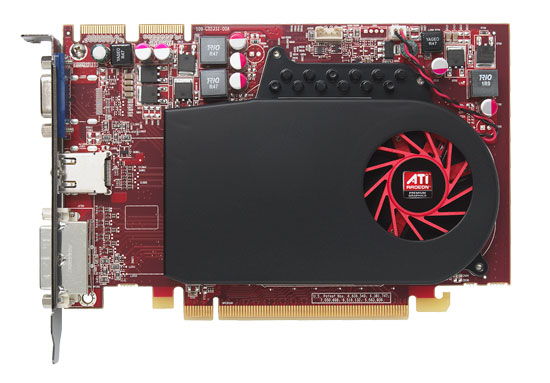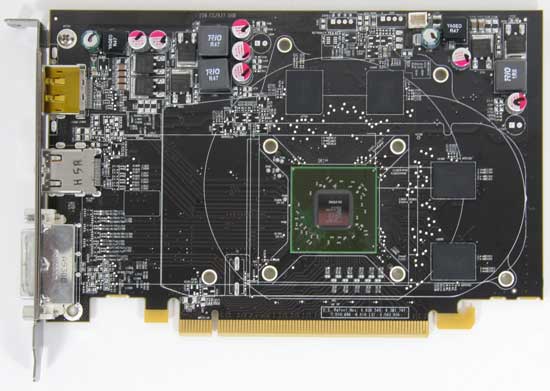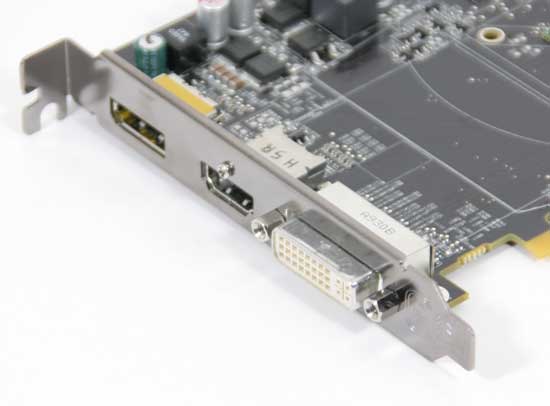AMD's Radeon HD 5670: Sub-$100 DirectX 11 Starts Today
by Ryan Smith on January 14, 2010 12:00 AM EST- Posted in
- GPUs
Meet The 5670
Today’s launch is the Redwood based Radeon HD 5670. The 5670 is a full Redwood card, with all of its functional units enabled and running at its “full” clockspeed. The card we’re looking at is clocked at 775MHz core, and 1GHz(4GHz data rate) on the GDDR5 RAM. With a 128-bit memory bus, this gives the card 64GB/sec of memory bandwidth.

AMD stock photo, our sample boards are black and don't have CF connectors
AMD will be launching the card in a 512MB and 1GB configuration. The $99 card we’re looking at is a 512MB model, while the 1GB model will run $15-$20 more.

Attached to the card are 4 128MB Hynix GDDR5 RAM chips. These chips are specified for a 4GHz data rate, so AMD is only finally pairing up 5000-series cards with appropriately fast RAM. What this means is that unlike the 5700 and 5800 series, there won’t be any freebie memory overclocking to take advantage of the gap between the card’s clocks and what the RAM is specified for. What you see is what you get.
As is common for cards targeted at the sub-$100 price range, the 5670 runs sans external power. AMD puts the TDP for the card at 61W, which compares favorably to the 70W of the GT 240 that we saw last week. AMD tells us that they were merely designing this card to be under 75W, and that the 61W TDP of the shipping product is a good bit lower than they had been planning on.
With the lower power usage of this card, the need for a dual-slot cooler (and the 5000 series distinctive shroud) is gone. The 5670 is equipped with a slightly larger than normal single-slot blower, which blows air towards the front of the card. We call this cooler slightly larger than normal since AMD has extended the heatsink portion slightly to cover all of the GDDR5 RAM chips on the card, as evidenced by the heatsink jutting out of the top. This is an interesting design choice from AMD, since other cards like the 5750 do not apply any cooling to the GDDR5 RAM chips. This does leave us wondering whether cooling the RAM is necessary, or if AMD is doing it for cosmetic reasons.

The card measures at 6.61”, and finally drops AMD’s traditional Eyefinity port configuration. By moving to a single slot, AMD has dropped the 2nd DVI port, leaving the card with a DisplayPort, an HDMI port, and a dual-link DVI port. The card will be able to drive a second DVI monitor using an HDMI-to-DVI adapter, although only a single link. The 5670 still has full Eyefinity capabilities, and a 3rd monitor can be hooked up to the DisplayPort for that task. AMD tells us that the Redwood chip can actually drive 4 monitors, but none of the launch cards will configured for that (not that the 5800 cards were either). AMD’s ideal Eyefintiy configuration for this card is to pair it up with a trio of cheap 16:9 19” monitors, although as we’ll see the card doesn’t really have enough power for gaming like this.
The need for an active DisplayPort adapter is still an issue however, and at $99 the adapters are as much if not more than the card itself. At this point the best solution is a DisplayPort native monitor, but those are still fairly rare and seldom cheap.










73 Comments
View All Comments
JarredWalton - Sunday, January 17, 2010 - link
As far as CPU multiplier, if you have the i7-720QM the normal multiplier is 12X (133 bus * 12 = 1.6GHz). For the i7-820QM the stock multiplier is 13 (1.73GHz). Maximum Turbo mode on the 720QM is 2.80GHz, so you could potentially see a 21X multiplier, while on the 820QM the maximum Turbo is 3.066GHz so you'd see up to a 23X multiplier. I don't know if throttle stop tells you max and min multipliers or not, but you could even run CPU-Z and just watch to see if the multiplier is changing a lot.SlyNine - Tuesday, January 19, 2010 - link
Yea I have been watching a few programs including throttle stop, Realtemp and Realtemp GT, including I7 turbo. They all show the max multiplier at 7-9 when gaming under load, even with an external monitor hooked up and this screen off it doesn't go past 10. Its worth noting that with the screen brightness turned down and CPU load only they stay at 12, but turn the brightness up and your multi falls to 8.The biggest problem is the clock modulation, which I'm trying to test. But it definitely correlates with real world performance, while task manager may show the CPU at 100%, throttle stop reports a 75% reduction in CPU usage. This also correlates with the delta that taskmanager indicates CPU usage at and what programs like I7turbo and real temp show the C0 state percent. Task manager will show 100% while the C0% will be at 25%, indicating a 75% reduction while under load.
Perhaps throttle stop just measures the difference between the CO% and what the OS reports.
I've custom set all the settings in the advanced power options to be the same on and off battery. When you unplug the system runs a great deal faster, albeit at the risk of harming the battery. I've disabled speed step as well with no difference.
Excel isn't my strong suit(basically I'm going to have to relearn how to use it) but I'm trying to correlate frame rate with the indicated clock modulation. But I'm unsure how to record a timeline of FPS. It does appear though that the FPS do report accurately when the clock modulation kicks in.
satish2685 - Monday, April 1, 2013 - link
Hi, I would like to purchase an Entry level 1GB DDR3 Asus Geforce HD5450 Graphics Card, but considering the power requirements, i only have an 250W PSU. Is it ok to buy a graphic card that requires a minimum of 400w and connect it to my existing MB or do i need to upgrade my PSU?? Advice required. If so any consequences i could face in future ??